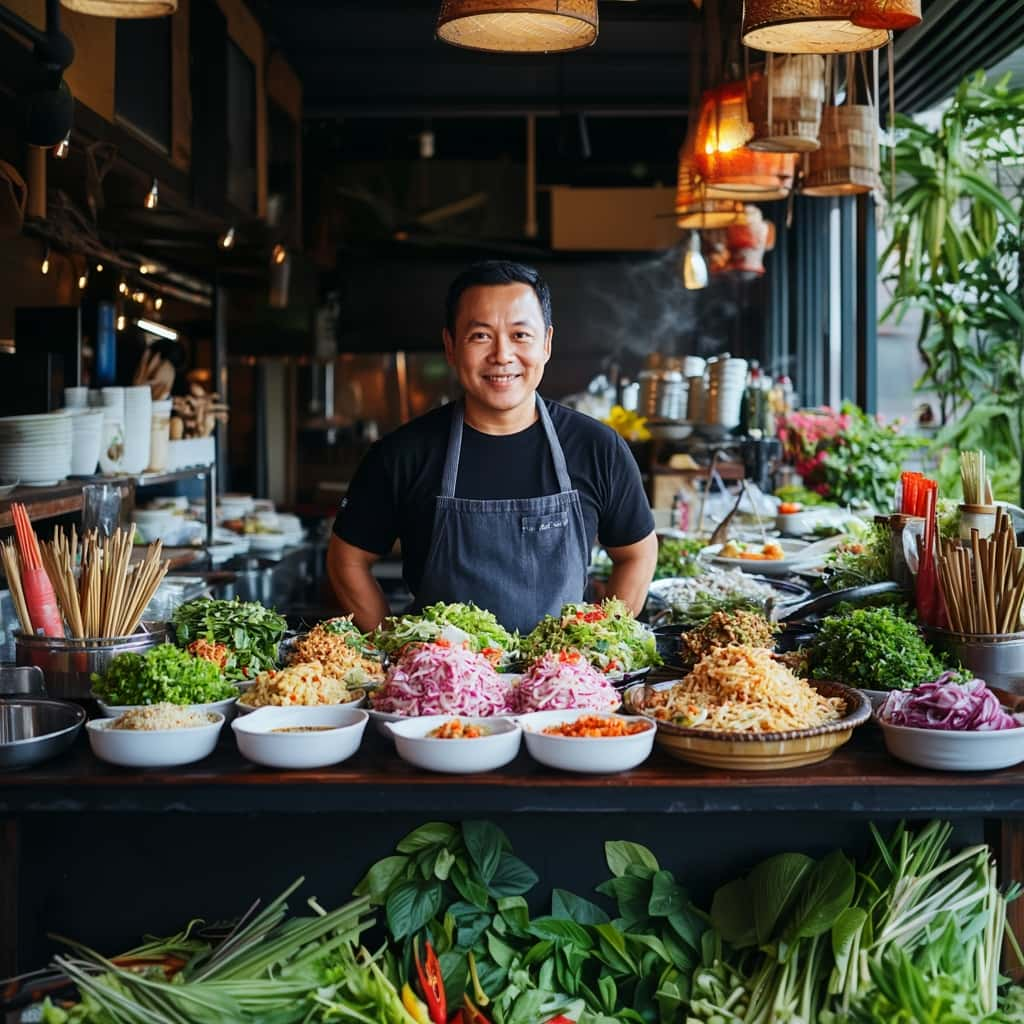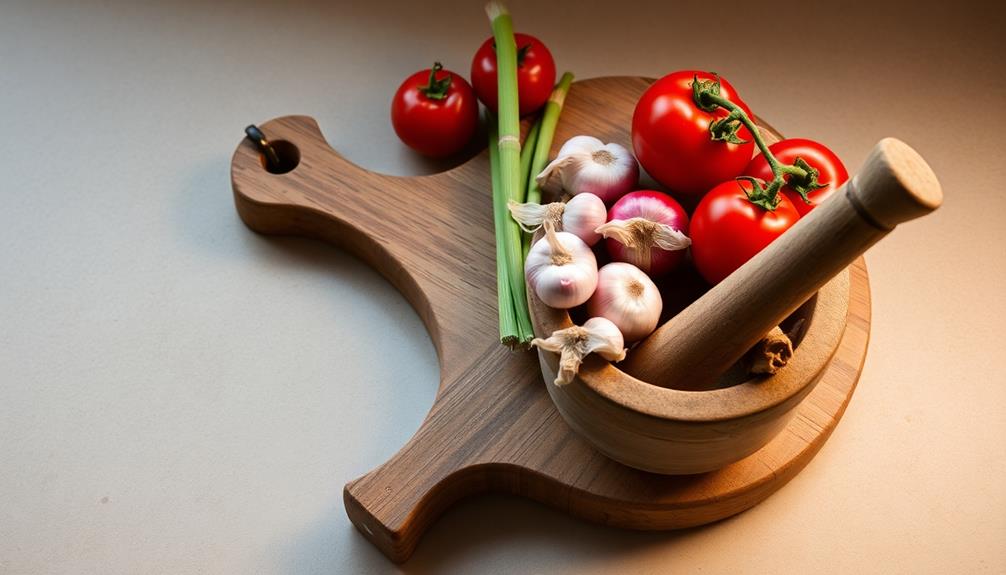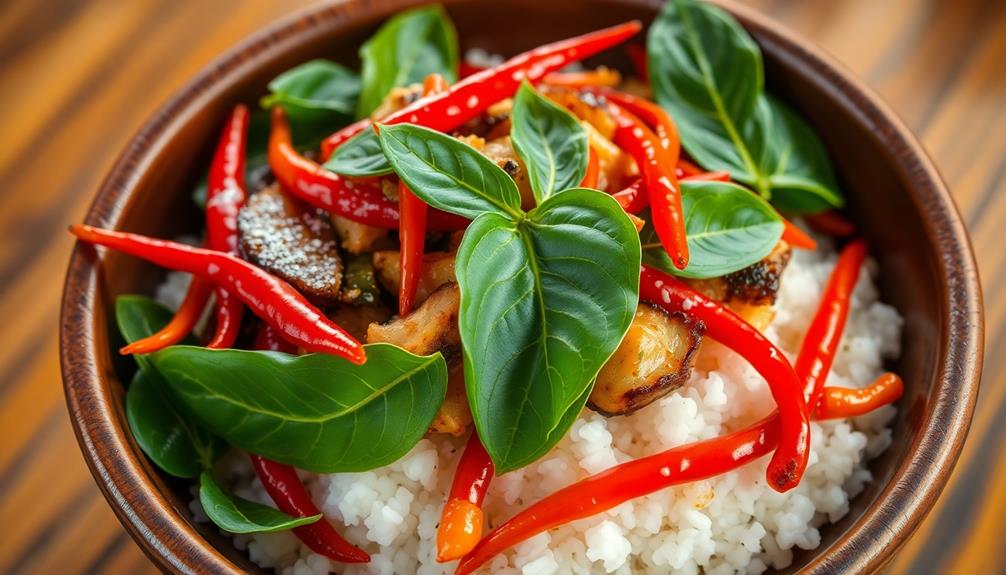Hailing from the vibrant Isan region of northeastern Thailand, the savory and aromatic Sai Krok Isan sausage is a beloved traditional delicacy that's been perfected over generations. This unique pork sausage blends ground meat with rice flour, fish sauce, and an array of aromatic spices like garlic, galangal, and kaffir lime. After fermenting for 2-3 days, the sausages are grilled or fried until crispy, then served hot with sticky rice and refreshing veggies. The complex flavors and textural contrast make Sai Krok Isan a true taste of Isan's rich culinary heritage. Discover more about this captivating sausage and the stories it carries.
Key Takeaways
- Sai Krok Isan is a traditional delicacy and staple in the local cuisine of Northeastern Thailand, known for its unique flavor profile and cultural significance.
- The sausage is made from ground pork, rice flour, and a blend of Thai spices, including garlic, galangal, and kaffir lime leaves.
- The fermentation process, which can take 2-3 days, enhances the savory, slightly tangy, and sweet flavors of the sausage.
- Sai Krok Isan is often enjoyed as a street food and is a crucial part of local festivals and celebrations in the Isan region.
- The preparation and techniques of Sai Krok Isan have been refined over generations, reflecting the communal aspect of dining and the culinary heritage of Northeastern Thailand.
History
Sai Krok Isan, a type of fermented sausage, has a rich history rooted in the Isan region of northeastern Thailand. This traditional delicacy has been a staple in the local cuisine for centuries, passed down through generations of families.
The process of making Sai Krok Isan is a labor of love, involving the careful selection of ingredients, meticulous preparation, and patient fermentation.
The origins of this sausage can be traced back to the farming communities of Isan, where pork was plentiful and preservation methods were crucial. By fermenting the pork, the local people were able to extend its shelf life and create a flavorful, unique sausage that could be enjoyed year-round.
Over time, the recipe and techniques have been refined, with each family adding their own special touch to the final product.
Today, Sai Krok Isan remains an integral part of Isan culture, not just as a delicious food, but as a symbol of the region's rich culinary heritage and the enduring traditions of its people.
Recipe
Sai Krok Isan is a fermented pork sausage that's a popular street food in the Isan region of Thailand. The unique flavor and texture of this dish come from the process of fermenting the pork over several days. This recipe will guide you through the process of making Sai Krok Isan at home.
Preparing the pork mixture for Sai Krok Isan involves a delicate balance of seasoning and fermentation. The resulting sausage is a flavorful and versatile ingredient that can be enjoyed on its own or incorporated into a variety of dishes.
- Ground pork
- Rice flour
- Fish sauce
- Salt
- Garlic, minced
- Galangal, minced
- Coriander roots, minced
- Kaffir lime leaves, finely chopped
- Bird's eye chili, finely chopped (optional)
In a large mixing bowl, combine the ground pork, rice flour, fish sauce, salt, garlic, galangal, coriander roots, kaffir lime leaves, and bird's eye chili (if using). Mix the ingredients thoroughly until they're well combined.
Cover the bowl and let the mixture ferment at room temperature for 2-3 days, stirring occasionally.
Once the fermentation process is complete, the Sai Krok Isan sausage can be formed and cooked. To do this, take a small portion of the fermented pork mixture and shape it into a sausage-like form.
Grill or fry the sausages until they're cooked through and have a crispy exterior. Serve the Sai Krok Isan sausages hot, garnished with fresh chilies, lime wedges, and sticky rice, if desired. Enjoy this authentic Isan street food at home!
Cooking Steps
First, chop the pork and chicken meat into small pieces.
Next, mix the spices and meats together until well combined.
Then, stuff the sausage mixture into casings, twist and tie the casings, and hang the sausages to ferment.
Step 1. Chop Pork and Chicken Meat
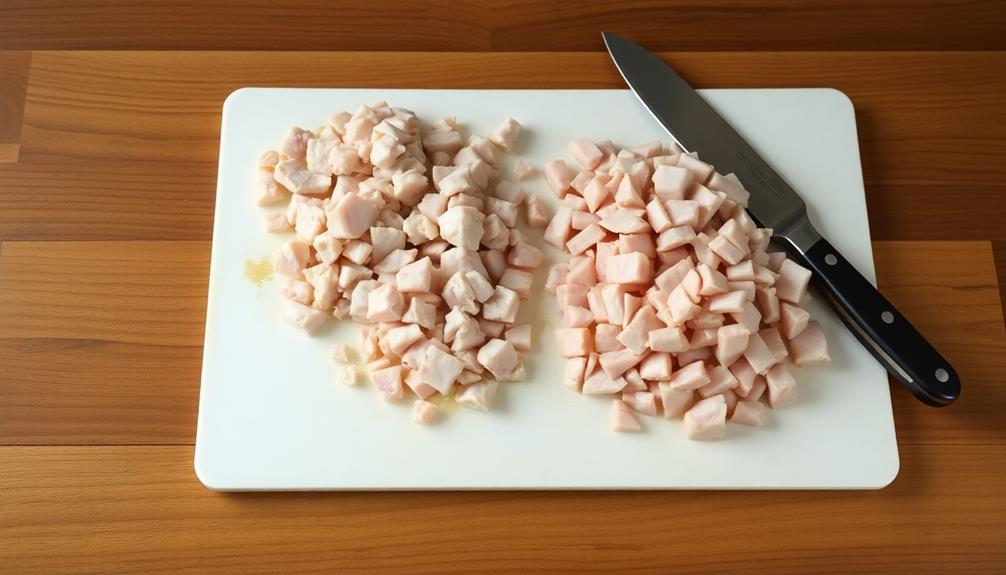
To prepare the pork and chicken meat, begin by cutting the raw proteins into bite-sized pieces. You'll want the chunks to be around 1/2-inch in size, so they'll cook evenly and be easy to chew. Use a sharp knife and cutting board to dice the pork and chicken – this step is crucial for the right texture in your sausage.
Once the meats are chopped, transfer them to a large mixing bowl. You'll need about 1 pound of pork and 1/2 pound of chicken for a full batch of Sai Krok Isan sausage.
Gently combine the proteins with your hands, taking care not to overmix. Overworking the meat can make the sausage texture tough. Just lightly toss the pork and chicken together until they're evenly distributed.
With the chopping and mixing done, you're ready for the next step in the sausage-making process. Keep those knife skills sharp!
Step 2. Mix Spices and Meat
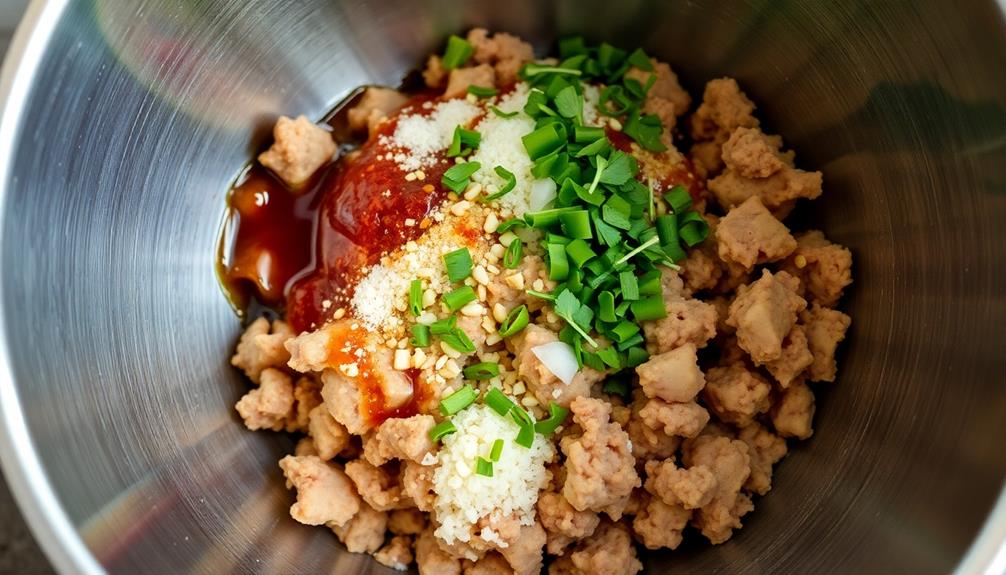
With the pork and chicken neatly chopped, it's time to season the meats. In a large mixing bowl, combine the chopped meats with a generous amount of ground coriander, cumin, and white pepper.
Don't be shy with the spices – you want the flavors to really shine! Knead the mixture thoroughly with your hands, making sure the seasonings are evenly distributed.
Next, add a splash of fish sauce and a sprinkle of salt. The fish sauce will lend a savory, umami-rich note, while the salt enhances all the other flavors.
Keep kneading until the mixture is well-incorporated and has a slightly sticky texture. Now it's time to start stuffing the sausage casings.
Gently pack the seasoned meat into the casings, taking care not to overstuff them. Twist the casings into links, leaving a bit of space between each one.
With the sausages ready, you can now move on to the final cooking steps. Get ready for some mouthwatering Sai Krok Isan!
Step 3. Stuff Sausage Into Casings

Take the seasoned meat mixture and gently pack it into the sausage casings. Be careful not to overstuff the casings, as you'll want to leave a little room for the sausage to expand during cooking.
Once the casings are filled, tie off the ends to seal in the meat.
Next, use a fork or your fingers to prick any air pockets in the sausage. This will help prevent the casings from bursting during the cooking process. You can also twist or tie the sausages into small links at this stage, if desired.
Now, it's time to cook your Sai Krok Isan. You can grill, pan-fry, or even bake the sausages until they're cooked through and the casing is crisp.
Serve your homemade Northeastern Thai sausages warm, with sticky rice and your favorite dipping sauces on the side. Enjoy the bold, spicy flavors of this beloved regional specialty.
Step 4. Twist and Tie the Casings

After filling the casings, you'll want to twist or tie them into small links. This helps keep the sausage together and gives it a nice, uniform shape. To do this, simply grab a casing near the end and give it a few twists, forming a link.
Then, use your fingers to pinch the twisted part and tie it off with a tight knot. Continue this process down the length of the filled casing, creating a string of evenly-sized sausage links.
Be gentle but firm as you twist and tie. You don't want to tear the casing, but you also need to secure the sausage well. If the links seem too long, you can always cut them in half with a sharp knife.
Once all the links are tied, you can hang them or place them in the fridge until you're ready to cook. This twist-and-tie method is the perfect way to finish up your homemade Sai Krok Isan sausages.
Step 5. Hang Sausages and Ferment
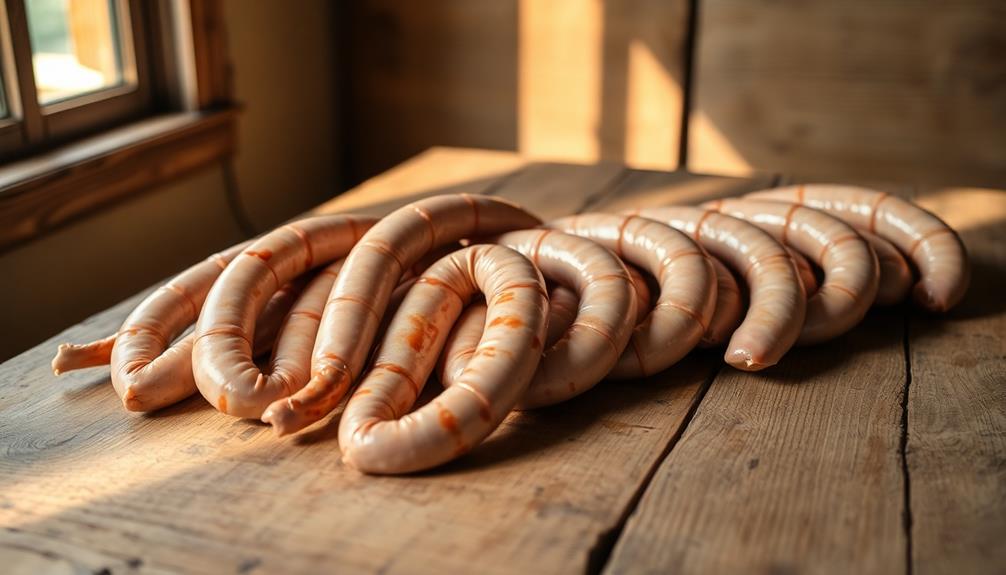
The next step in the process involves hanging your freshly-twisted Sai Krok Isan sausages to facilitate fermentation.
Find a cool, well-ventilated spot and suspend the sausages from a rod or railing, leaving a few inches of space between each one. This allows air to circulate and encourages the growth of beneficial bacteria that will give your sausages their signature tangy flavor.
Over the next 2-3 days, the sausages will gradually firm up and develop a slightly sticky surface as they ferment.
During this time, you'll want to rotate the sausages occasionally to ensure even drying. Keep an eye out for any signs of spoilage, like off-putting odors or visible mold. If all looks good, your sausages are ready for the final step – smoking.
Smoking the fermented Sai Krok Isan sausages will lend them a delightful layer of smoky complexity.
Hang the sausages over smoldering hardwood chips or charcoal, and let the fragrant smoke work its magic for 1-2 hours. Then, they're ready to enjoy!
Final Thoughts
For those seeking a truly authentic taste of Isan, the Sai Krok Isan is a must-try delicacy. This unique sausage, with its rich, fermented flavor and satisfying texture, is a testament to the region's culinary heritage.
While the process of hanging and fermenting the sausages may seem daunting, the end result is well worth the effort.
The final step in creating the perfect Sai Krok Isan is to enjoy it alongside traditional accompaniments, such as sticky rice, fresh vegetables, and a spicy dipping sauce. The sausage's complex flavors pair beautifully with these complementary elements, creating a harmonious and immensely satisfying dining experience.
Whether you're a seasoned Isan enthusiast or a newcomer to the cuisine, the Sai Krok Isan is a must-try. Embrace the unique flavors and traditions of this beloved regional specialty, and you'll be rewarded with a truly unforgettable taste of Northeastern Thailand.
Frequently Asked Questions
What Are the Typical Ingredients Used in Sai Krok Isan?
You'll typically find ingredients like ground pork, roasted sticky rice, red chili peppers, fish sauce, lime juice, and perhaps a few herbs and spices in this traditional Thai sausage.
How Long Can Sai Krok Isan Be Stored Before Consuming?
Typically, the sausage can be stored for up to 5 days in the refrigerator. Make sure to keep it in an airtight container and consume it before it goes bad. Proper storage ensures the sausage remains fresh and flavorful.
What Are the Health Benefits of Eating Sai Krok Isan?
Eating this homemade sausage can provide health benefits. It's a source of protein, which supports muscle growth and repair. The fermentation process may also improve gut health by increasing beneficial bacteria. Enjoy it as part of a balanced diet.
Can Sai Krok Isan Be Found in Markets Outside of Northeast Thailand?
You can find sai krok isan outside of Northeast Thailand, but it might be harder to come by. It's a specialty regional dish, so it's not as widely available in other parts of the country or internationally. However, if you’re interested in trying other traditional dishes from Thailand, you can easily find popular dishes like pad Thai, green curry, and tom yum soup in Thai restaurants around the world. And if you’re feeling adventurous, you can even try making your own sai krok isan at home using a traditional Thai omelet recipe. This way, you can experience the unique flavors of Northeastern Thai cuisine no matter where you are located.
Is Sai Krok Isan Suitable for Vegetarians or Vegans?
No, sai krok isan wouldn't be suitable for vegetarians or vegans. It's a pork-based sausage, so it contains meat. You'd need to find a plant-based alternative if you're looking for a vegetarian or vegan version of this Thai specialty.


